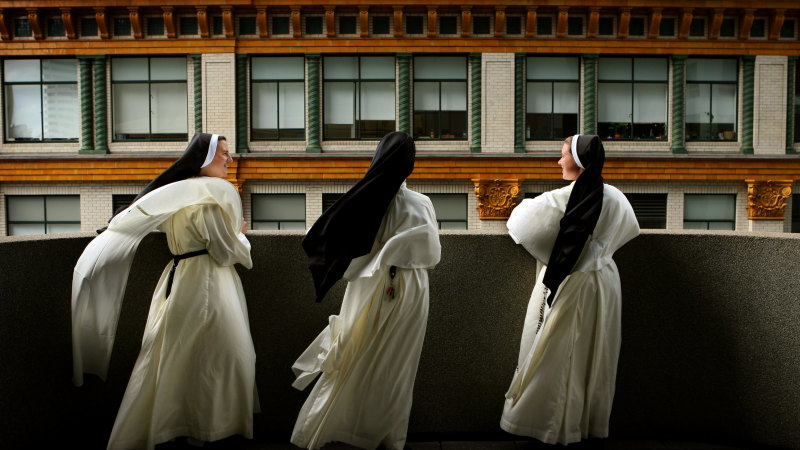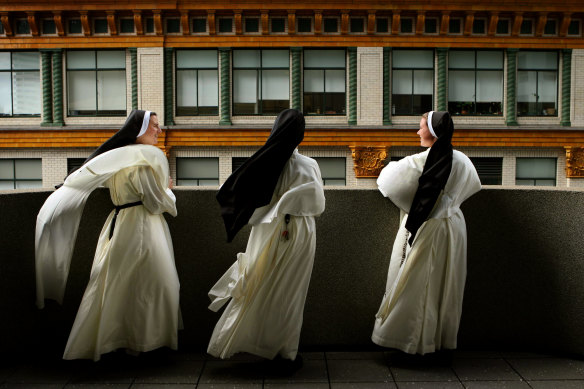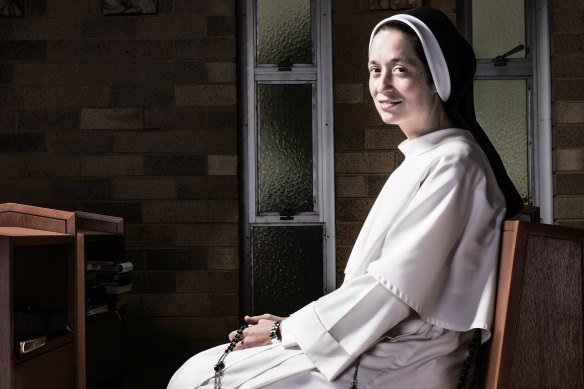Surprise split among Catholic women over sex, divorce and patriarchy

Save articles for later
Add articles to your saved list and come back to them any time.
Although Australian Catholic women are frustrated about discrimination, abuse and patriarchy in the church, a study has exposed a surprising generational divide: older women are hungry for reform, but younger devotees have little interest in relaxing rules on sex, contraception and the priesthood.
Most older women – particularly those aged over 55 – were dissatisfied with the lack of options for leadership, the gendered language in the liturgy, and the ban on remarriage after divorce – but many of those aged 40 and below supported the status quo.
The Dominican Sisters of St Cecilia, whose sisters still wear a habit, is attracting young recruits. Credit: Steven Siewert
The authors of the study – which surveyed 17,200 women from 140 countries, including 1769 from Australia – say the generational difference could be due to life experience, the influence of migration, or the fact young people grew up in a more conservative church.
“There has been a push back towards conservatism [in Australian Catholicism],” said co-author Tracy McEwan, a theologian and sociologist of religion at the University of Newcastle. “I think that’s been impactful for young adults in the church.”
However, she said women of all ages expressed disappointment, frustration and challenge with the church. “[There was] a feeling that some women’s voices weren’t heard in the church. That was across age.”
The global study, led by the University of Newcastle, comes as Pope Francis leads a discussion about whether women should have a greater role in church governance and ceremonies. He has ruled out the priesthood, but not the diaconate.
Australian women were more conservative than their overseas peers on reform; 74 per cent said they wanted it, compared with the global average of 84 per cent. The authors defined conservatism as adherence to Catholic doctrine and embrace of traditionalism.
A deeper look at the Australian results, which will be made public on Tuesday, found this was driven by younger women. While three-quarters of respondents supported reform, that fell to less than half (44 per cent) in the 18 to 40 age group (for the 56-70s it was 87 per cent, and for the over 70s it was 94).
In the survey’s comments, there was disagreement about what reform meant. Older women wanted the church and its teachings to change, while the report said “there was a smaller, younger cohort of respondents who rejected any modernisation of the church and understood reform as a return to orthodoxy and tradition, including the traditional Latin mass”.
Fewer than one in three of those under 40 supported inclusion of women at all levels of the church (for those older than 70, it was 93 per cent), or the idea of female preachers and priests.
In the comments, one younger respondent said, “the more [the church] retains and propagates the biblical and traditional teachings on [women], the more nourishing it will be for us as women”. But another, aged over 70, said: “Widen the tents, or the exodus will continue.”
Dominican sister Maria Kolbe entered the order when she was 20, after giving away all her clothing. Credit: Andrew Goldie
Allowing more freedom of choice on sex and contraception was rejected by two in three of those under 40; the 41 to 55s were about half-half, but the 56 pluses backed the idea enthusiastically.
The question of remarriage after divorce also drew less support from young Catholics, while older women talked about being shunned as divorcees, especially if there was violence in their marriage. “After my husband left me, I didn’t feel like I belonged anymore,” said one.
But there was agreement from all age groups that the misuse of power by male clerics was damaging the church, that leaders needed to do more to address forms of abuse, and that the institution was not doing enough to address the cover-up of sexual abuse.
Co-author Kathleen McPhillips, a sociologist at the University of Newcastle, said life experience could be a factor. “The young women may not have had that experience yet, of wanting the change, fighting for it, and not seeing it develop,” she said.
As the survey was opt-in, it may have attracted more young women who were highly engaged in the church, rather than those who might be alienated from it.
“Another factor could be migration and ethnicity,” she said. “Many people who attend church have English as a second language, and may be first or second generation from countries like the Philippines, where Catholicism is very different.”
The shift in youth attitudes can be detected in the religious orders attracting young women. The numbers of nuns in orders such as the Sisters of Mercy are declining, but the Dominican Sisters of St Cecilia – which continue to wear a habit, despite a ruling against them in Vatican II – are growing.
A young Australian woman, Sister Hannah Rose Dobson – a speech therapist from the Blue Mountains – made her first profession of poverty, chastity and obedience at the order’s Nashville centre last year.
The Morning Edition newsletter is our guide to the day’s most important and interesting stories, analysis and insights. Sign up here.
Most Viewed in National
From our partners
Source: Read Full Article

